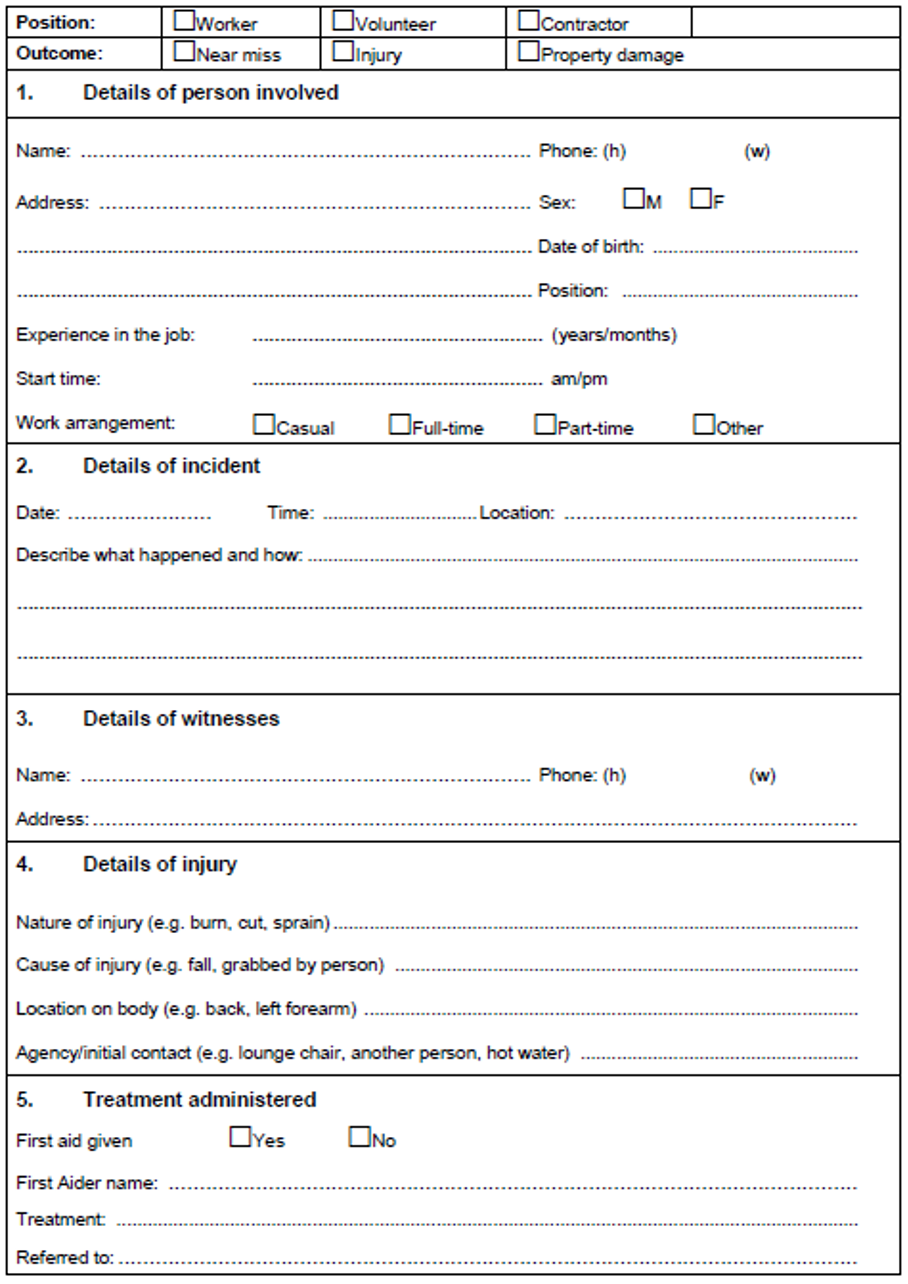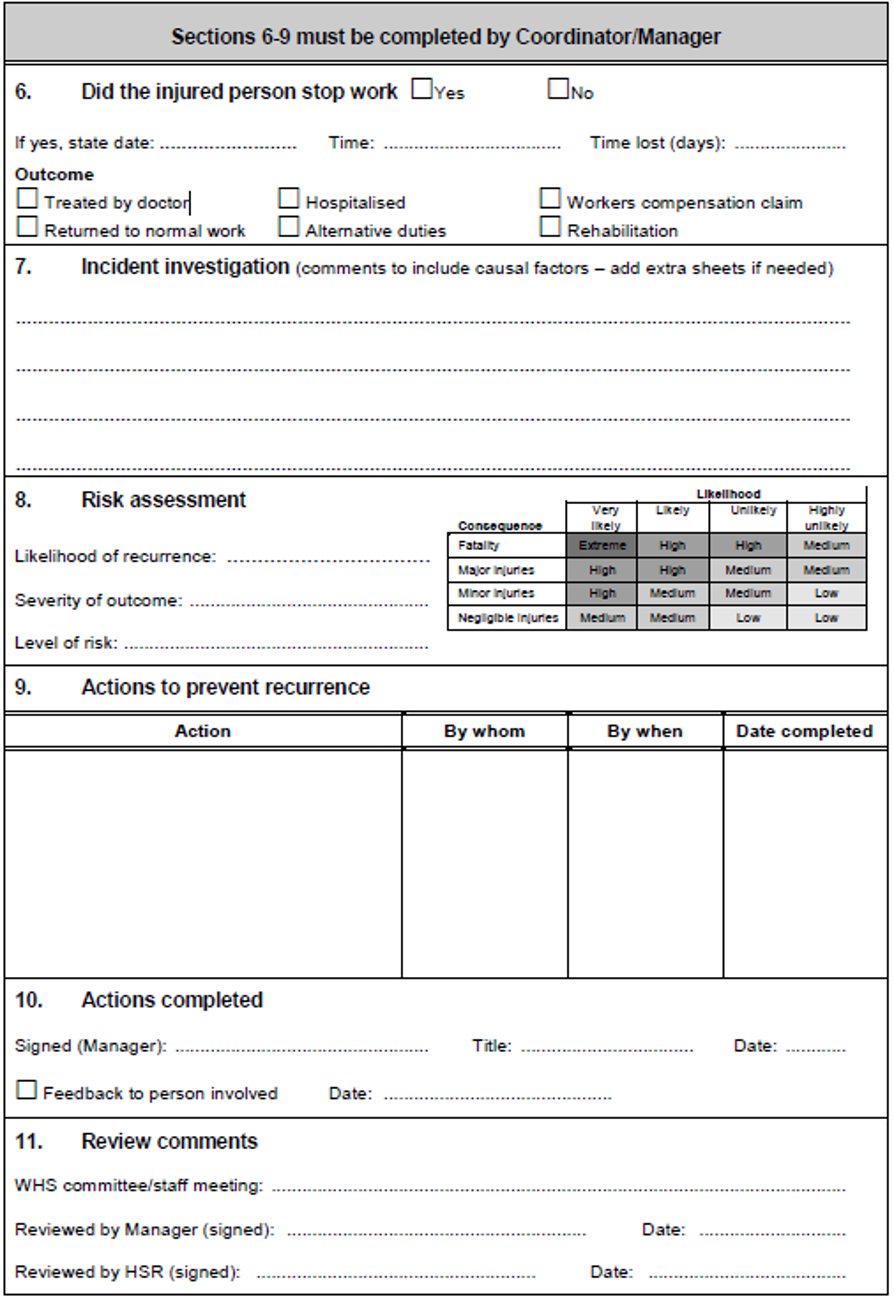In this section you will learn to:
- Develop WHS record-keeping policies and procedures and provide information to workers
- Evaluate WHS record-keeping policies and procedures for compliance with legislative requirements
- Monitor hazard, incident and injury reporting processes to meet legislative requirements and inform future prevention strategies
Supplementary materials relevant to this section:
- Reading J: Record Keeping
- Reading K: Incident Management and Reporting Guidelines
- Reading L: Incident/Injury Investigation: WHS Procedures
PCBUs, officers, and managers are also required to monitor their organisation’s compliance with all WHS and risk control processes and evaluate this information to help inform continuous improvement within the organisation. In this section of the module, you will learn more about key processes involved in doing this.

Appropriate record keeping is a mandatory requirement under WHS legislation. In some cases, WHS records may be requested by a regulator or inspector to ensure compliance with WHS Acts and Regulations. Keeping appropriate records can also enable PCBUs/officers to:
- Demonstrate how decisions about controlling risks were made
- Target training at key hazards identified
- Prepare safe work procedures based on the evidence
- Review risks following changes to legislation or business activities
- Demonstrate to others (regulators, investors, shareholders, customers) that WHS risks are being managed
(Safe Work Australia, 2018, p. 25)
Ultimately, in addition to meeting legislative requirements, WHS records offer a plethora of information relating to hazards, incidents, and injuries in the workplace. This data can be used to identify whether or not WHS processes are working and improve processes through the analysis of trends and issues.
Therefore, it is important for PCBUs/officers to ensure that appropriate WHS record-keeping policies and procedures are in place and that all workers are aware of their requirements for WHS record keeping. Let’s look at how such policies and procedures can be developed.
Next watch this video from Duke University explaining record keeping.
The first step to developing record-keeping policies and procedures is to access and interpret legislative requirements on record-keeping that are applicable to the organisation. This information may be accessed directly through a review of relevant legislation or through information provided by Safe Work Australia and individual state/territory WHS authorities.
Reading
J – Record Keeping
Reading J is a short extract that outlines record-keeping requirements suggested by WorkSafe ACT. It is important that you find out what are legislative requirements as applied to your state/territory and organisation.
Self Reflection
Before reading on, take a few minutes to reflect on how you would gather information about WHS record-keeping requirements if you were a PCBU or officer for an allied health organisation. How would you ensure that you were meeting your legislative requirements and keeping adequate WHS records and documentation?
While there are some state/territory-based differences, most organisations are required to keep similar types of records.
These requirements include:
- injury/incident reports and investigations*
- workers rehabilitation and compensation records*
- first aid records
- chemical register identifying those which are classified as hazardous substances and including Material Safety Data Sheets (MSDS)
- risk assessments and controls
- training records
- certificates and licences
- maintenance and testing records (e.g. Residual Current Device [RCD] tests)
- hazard report forms (and actions taken)
- workplace inspection/safety check forms
- major incident/dangerous occurrence reports
These records must be kept confidential and access only allowed to authorised personnel.
(Adapted from SafeWork South Australia, 2014)
Ultimately, it is vital all PCBUs/officers ensure that their organisation’s WHS record-keeping policies and procedures comply with all legislative requirements. Record-keeping policies should outline the organisation’s commitment to WHS record-keeping and procedures should outline the practical steps required to implement the policy. Examples of the key information that should be included are outlined in the following table.
| WHS record-keeping policy |
|
|---|---|
| WHS record-keeping procedures |
|
(WorkSafe Victoria, 2006)
It is also important to ensure that the policies and procedures are:
- Written simply and clearly, so they will be understood by all employees and volunteers
- Comprehensive, consistent and compliant with relevant legislations and standards
(WorkSafe Victoria, 2006, p. 47)
To ensure quality record-keeping in key areas of WHS it is also useful to develop standardised forms for recording specific WHS information. Common examples of these are hazard checklists and incident report forms. Using standardised forms helps ensure that essential information is recorded in an organised way that is compliant with the legislative requirements. Of course, training workers in the use of these forms is also critical.
Part of the process of developing policies and procedures involves consulting with relevant workers. Wherever possible, draft policies and procedures as well as key forms should be discussed with workers so that improvements can be made before they are implemented. Once finalised, they must also be effectively communicated to all workers. Depending on how communication takes place in the organisation, these documents may be uploaded to the organisation’s intranet, distributed via email, physical copies provided to workers, or copies posted on noticeboards. It is important to ensure that all policies, procedures, and documents are easily accessible to workers. Essentially you want to ensure everyone in your organisation is aware of how to record WHS-related information and where these records should be kept.
Self Reflection
Why do you think it is so important to consult with workers when developing policies and procedures and creating key forms?
What do you think could happen if management did not consult with workers during this process?
What are some possible communication barriers or factors (e.g., worker attitudes, methods of consultation) that may affect effectiveness of consultation?

Under national WHS legislation, workplaces need to report certain types of workplace incidents to their state or territory regulator. These ‘notifiable incidents’ include:
- the death of a person
- a ‘serious injury or illness’ or
- a dangerous incident arising out of work carried out by a business, undertaking or a workplace
(Safe Work Australia, 2020, p. 1)
The following is adapted from Safe Work Australia (2020) and further explains incidents of ‘serious injury or illness’ that are notifiable.
Under national WHS legislation, workplaces need to report certain types of workplace incidents to their state or territory regulator.
Serious injury or illness must be notified if the person requires:
An injury or illness requiring the person to have:
- immediate treatment as an-inpatient in a hospital
- immediate treatment for:
- the amputation of any part of the body
- a serious head injury
- a serious eye injury
- a serious burn
- the separation of skin from an underlying tissue (such as degloving or scalping)
- a spinal injury
- the loss of a bodily function
- serious lacerations
- medical treatment (by a doctor) within 48 hours of exposure to a substance
Notification is also required for serious illnesses caused by:
- Any infection where the work is a significant contributing factor, including any infection related to carrying out work:
- with micro-organisms
- that involves providing treatment or care to a person
- that involves contact with human blood or body substances
- that involves handling or contact with animals, animal hides, skins, wool or hair, animal carcasses or animal waste products (including contraction of Q fever, Anthrax, Leptospirosis, Brucellosis, Hendra Virus, Avian Influenza and Psittacosis)
If a notifiable incident occurs, the model WHS Act sets out that the PCBU must immediately notify the regulator upon becoming aware of it. Under the legislation the PCBU becomes ‘aware’ of a notifiable event as soon as one of their supervisors or managers is aware of the incident. Failure to report a notifiable incident can result in large penalties. Therefore, it is vital for clear processes to be established for the reporting of incidents within the workplace.
Reading
K – Incident Management and Reporting Guidelines
Reading K includes an example of incident management and reporting guidelines from the University of Wollongong.
Additionally, investigation procedures should be carried out as soon as possible after an incident to look for causes of the incident and identify any unsafe work practices. This involves recording any physical evidence of the incident and taking notes about the events leading up to the incident, the incident itself, and what occurred after the incident. In the case of a notifiable incident, the Regulator of your State/Territory may request for relevant information and conduct an investigation.
Reading
L – Incident/Injury Investigations: WHS Procedures
Reading L offers an overview of the investigation procedures, including incident notification, information to be gathered and recorded, interview of personnel involved directly or indirectly, as well as reporting and follow-up actions.
To facilitate the process of incident investigation and reporting, you should develop standardised forms for incident reporting to guide workers in providing information relevant to the incident. An example of an incident/injury report form is included on the following pages. Analysing information from incident reports and investigations will help you to implement appropriate strategies in order to prevent similar incidents in the future. Of course, incident and injury reporting processes are not efficient if workers do not use them. Therefore, it is also important to ensure that all workers are aware of the reporting process (i.e., train them at induction and regularly provide refresher training). Ultimately, all workers need to know about the importance of completing such documentation and how it should be completed.
EXAMPLE INJURY/INCIDENT REPORT FORM


WHS policies and procedures must be continually evaluated to ensure organisational suitability and compliance with relevant legal requirements. SafeWork South Australia (2014) developed the following WHS Management Review checklist to help allied health organisations review whether they have met various WHS requirements. This checklist can be adapted as a tool to monitor your organisation’s WHS risk control processes and ensure adherence to WHS legislation.
| Yes | No | Comments | |
|---|---|---|---|
| Managing Hazards | |||
| 1. Pre-service checks of homes conducted | ☐ | ☐ | |
| 2. Checks reviewed regularly | ☐ | ☐ | |
| 3. Regular community venues checked before use (access etc.) | ☐ | ☐ | |
| 4. Offices inspected regularly | ☐ | ☐ | |
| 5. System in place for reporting hazards (e.g., hazard forms) | ☐ | ☐ | |
| 6. Hazards reported by workers | ☐ | ☐ | |
| 7. Processes in place to address: | ☐ | ☐ | |
|
☐ | ☐ | |
|
☐ | ☐ | |
|
☐ | ☐ | |
|
☐ | ☐ | |
|
☐ | ☐ | |
|
☐ | ☐ | |
|
☐ | ☐ | |
|
☐ | ☐ | |
|
☐ | ☐ | |
|
☐ | ☐ | |
|
☐ | ☐ | |
| 8. Risk assessments carried out on hazards | ☐ | ☐ | |
| 9. WHS considered when purchasing new equipment (e.g., for coffee, vehicles) | ☐ | ☐ | |
| 10. Controls reviewed for effectiveness | ☐ | ☐ | |
| 11. Client needs considered when addressing hazards | ☐ | ☐ | |
| 12. WHS considered when purchasing new equipment (e.g., for office, vehicles) | ☐ | ☐ | |
| Incident Reporting/Investigation | |||
| 1. Form available for reporting incidents and injuries | ☐ | ☐ | |
| 2. Workers (including contractors and volunteers) aware of the reporting procedure | ☐ | ☐ | |
| 3. Incidents investigated and documented | ☐ | ☐ | |
| Injury Management | |||
| 1. Procedures in place for claims management | ☐ | ☐ | |
| 2. Process in place to manage rehabilitation and return to work following injury | ☐ | ☐ | |
Additionally, management must ensure that all workers are complying with their WHS requirements within the organisation and that WHS policies and procedures are effective. Most organisations conduct regular reviews to ensure WHS processes are being used by workers and also conduct periodic audits of policies and procedures to ensure that they remain current and effective. A review of policies and procedures will also be necessary when there has been changes in relevant WHS legislations or changes within the organisation (e.g., organisational restructure, addition of new service, etc.).
During the evaluation process it is important to consider questions such as:
- Are the policies and procedures up-to-date?
- Are all WHS requirements being met?
- Has legislation changed since the creation of the procedures/documents?
- Are the policies and procedures still suitable for the organisation?
- Are workers trained in these policies and procedures?
- Are these policies and procedures understood and enforced by everyone in the workplace?
If anything is out-of-date or not aligned with current legislation, it must be updated to ensure compliance. Additionally, if changes are made, you will be required to communicate these changes to workers.
While evaluating WHS policies and procedures is the responsibility of PCBUs/officers, it is good practice to encourage feedback from all workers (indeed this is part of consultation processes). This helps to ensure that WHS processes remain effective within the organisation.

Other than meeting legislative requirements, WHS records are also used in WHS audits to identify any weak spots in a WHS management system and to devise appropriate prevention strategies. For example, investigation of incident reports can help you to identify hidden hazards or risks in the workplace so that appropriate actions can be taken to prevent or reduce future incidents. To help you understand this better, imagine that while reviewing incident reports you saw that three workers suffered the same injury while performing the same task in the last twelve months. This would be an indication of inadequate risk controls and would indicate the need for action to be taken to manage this risk in line with the hierarchy of control. This is why WHS policies and procedures require the recording of all injuries and incidents, regardless of size. The analysis of trends in illness or injuries within the workplace can help identify changes required for continuous improvement.
It is best practice to ensure that WHS records are monitored and reviewed on a regular basis so that workplace improvements can be identified and implemented to help ensure workplace safety.
In this section of the module you have learned about the importance of developing WHS record-keeping policies and procedures that comply with legislative requirements as well as the importance of monitoring and evaluating them. These processes are vital for the effective maintenance of the WHS management systems with an organisation.
